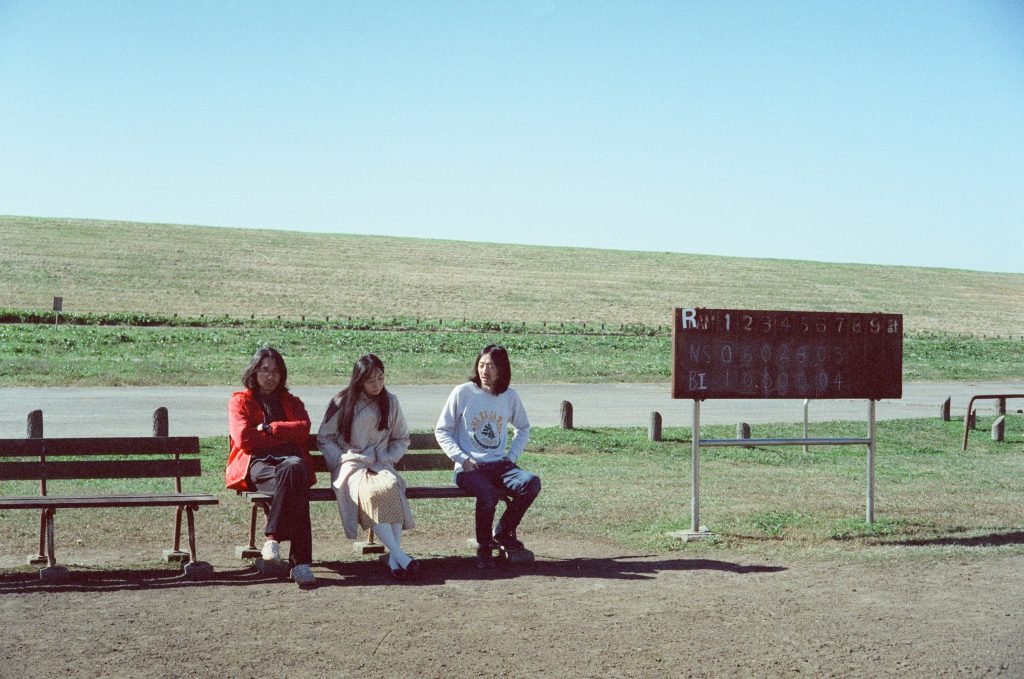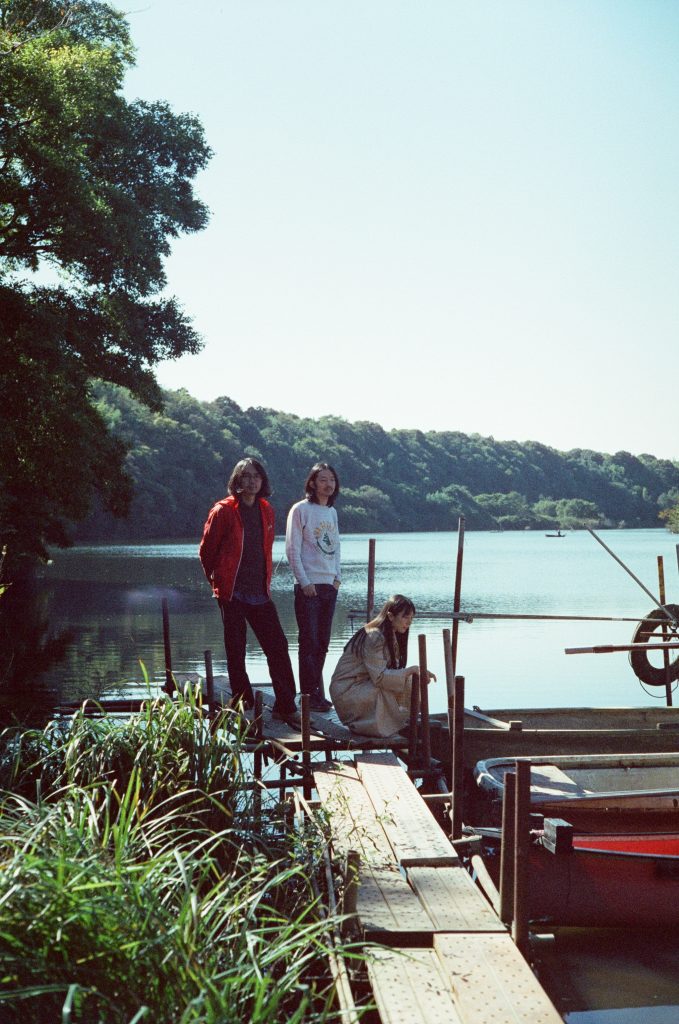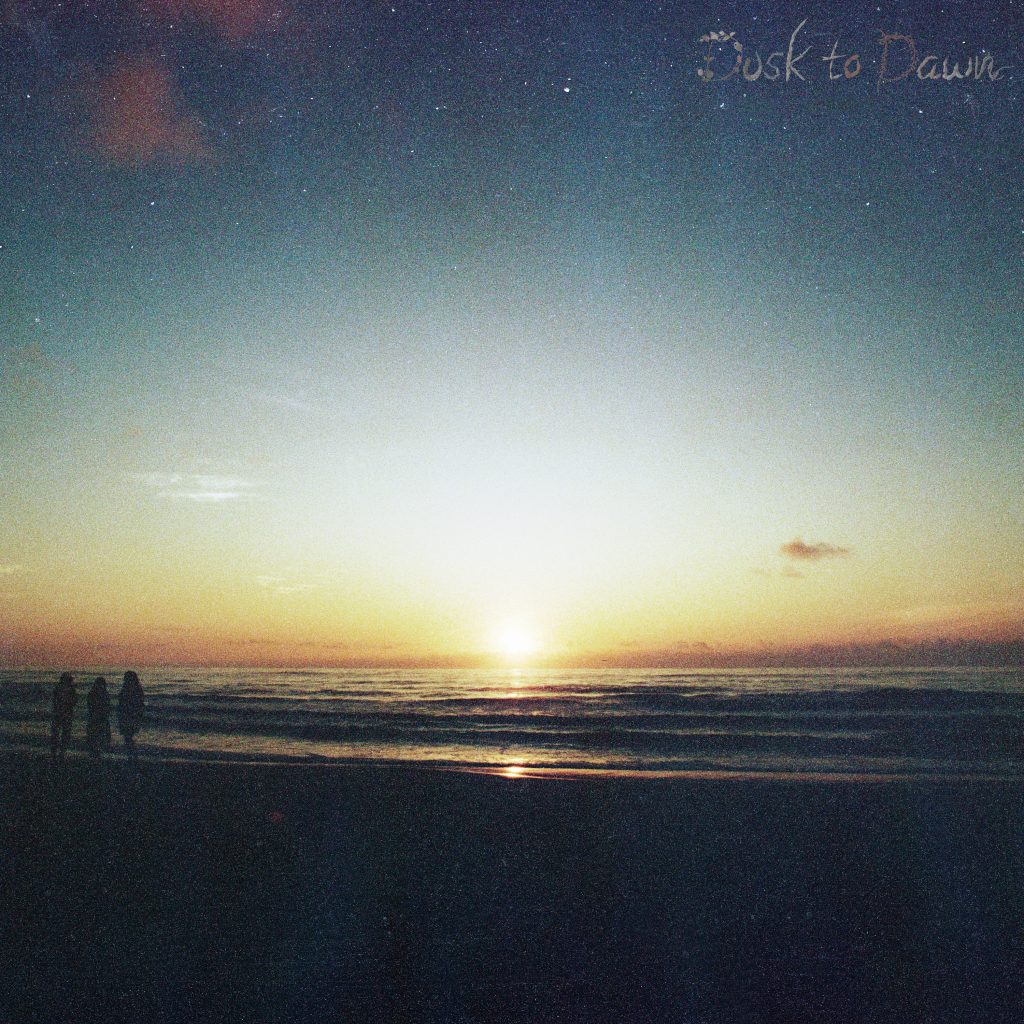
Lamp
Formed in 2000 by Taiyo Someya, Yusuke Nagai, and Kaori Sakakibara, Lamp released their first album Soyokaze Apartment Room 201from the indie label Motel Bleu in 2003. They were featured in Tower Records’ [NO MUSIC, NO LIFE]campaign in 2014. In 2017 and 2018, they went on an independent tour around East Asia respectively. The band released their eighth album, Her Watch, in 2018. Their independent shows at Liquid Room and Kinema Club were sold out. On October 10, 2023, Lamp’s latest album, Dusk to Dawn was released digitally.
https://www.lampweb.jp
On October 10, 2023, Lamp’s latest album, Dusk to Dawn, was released digitally. It is a 75-minute album consisting of 20 songs woven out of various elements such as Brazilian music, soul music, soft rock, folk, and even a touch of “Japanese.” While the album attracts listeners with its usual high quality, meticulous production, and sincere musicianship, it also catches our ears for its ambitious attempts, particularly in mixing, but also in composition and arrangement.
As has already been discussed in various places, Lamp is rapidly gaining popularity among listeners around the world over the past few years. Now, with more than 2.3 million monthly listeners on Spotify, they seem to have become one of the most popular Japanese artists among international listeners.
Against this backdrop, Dusk to Dawn was released without any prior publicity. How was this epic work produced? And what are their ambivalent feelings about their ” international popularity”? We interviewed three members, Taiyo Someya, Yusuke Nagai, and Kaori Sakakibara.
A voluminous work comprising twenty songs

–This new album, Dusk to Dawn, is your first new album in five years since your last album, Her Watch, released in 2018, so it seems there has been a bit of time, given how frequently you had released your previous works.
Taiyo Someya (Someya): Emotionally, we would like to release new works as often as before, but the more we have released, the higher the standards that we set for our work have become. Also, after being active as a band for such a long period of time, it has gradually become difficult to keep motivating ourselves. As for my personal life, my first child was born, and my mother had been thrown into a state where she needed nursing care before she eventually passed away while I was working on this project. Also, the biggest problem was that Yusuke Nagai, who was co-composing the music for the band with me, was feeling unwell.
Yusuke Nagai (Nagai): It is not a complicated story, but I just couldn’t motivate myself to make music. Since we are not the band that plays live all the time, I am not really aware that I am a musician except when we are recording. So, it is difficult for me to get into the right frame of mind when it comes time to make music. It’s like, in the midst of my daily life, the priority of making music is lowered.
–How about you, Sakakibara-san?
Kaori Sakakibara (Sakakibara): I have not had so many ups and downs. I was not particularly worried about Nagai. He had always been like that, so I thought it was nothing too serious (laughs).
Nagai: Well, I don’t think it was a slump because I was not necessarily feeling that I couldn’t stand making music anymore. However, there were many times when I wondered if I would ever be able to finish this piece. In fact, I only finished a few songs on this album by myself, but I managed to complete most of the songs with the help of Someya and Kaori.
–How did you end up with an album with a total of 20 songs in that situation?
Someya: I started writing and shaping songs around 2019, and around November of that year, I could see the album’s basic concept. At that point, I told the two of them that I would write seven songs and Nagai would write five, and we had set March 2020 as a tentative deadline. However, as he mentioned earlier, Nagai’s songs didn’t come in, and in the meantime, I wrote a lot more songs than I had planned, so we had a stockpile of songs. I thought that it would be an excellent opportunity to release such voluminous work that could even be released as a double vinyl set. With single-song releases becoming the norm, I thought that releasing a 20-song album would have a significant impact.
–It’s not just that the album contains so many songs. Each song reaches a high degree of perfection so that the album’s content is very rich.
Someya: Thank you very much. I don’t mean to brag, but this is really an album that I took the lead and worked hard on (laughs). That’s why I credited myself as a producer for the first time.
— I can sense the power and passion Sometani had to lead the band through the album’s content. I guessed that you took the lead not only in the creative aspect but also in the administrative aspects involved in the production process.
Nagai: Yeah, you are right. Now that I am older, I truly respect how well-organized and diligent Someya is. I used to tease him a little for being so in the past, though (laughs). Seriously, that’s part of the reason why the band keeps going.
Sakakibara: Yeah, that’s right.
Creating each song carefully

— In this day and age, it is possible to produce music in a smaller team by making full use of DAWs, even if you compose music by layering live instruments in a constructive manner. However, looking at the credits of this work, I was surprised, by the fact that a huge number of musicians actually participated in the session. I thought it would be quite a painstaking task just to coordinate the schedules of these people. You can’t take this kind of approach with independent releases without passion.
Someya: That’s exactly right. I started to feel more energized in this year, and I took care of all the administrative work including schedule coordination. This album is extraordinary in that it needed such administrative hard work and passion for creation, as well as in that we spent a considerable amount of money on it, which is very rare today.
— My impression is that the hybrid nature of Lamp’s music, which draws on Brazilian, soul, and pop music, has been deepened through repeated and careful sessions.
Someya: I wanted to create each song carefully. If I were to create something that could be completed in my home studio, I felt that it would not be something I would be satisfied with.
–In an interview several years ago, you said that you had a complex regarding your singing voice. How was the voice recording session for this album?
Nagai: I still can’t get used to it. It’s not as bad as it used to be, but I still feel stressed when I hear my own voice.
–I think you have a wonderful and prodound voice, which can be described as a “singer/songwriter voice.”
Nagai: I understand what you are mean, but when it comes to my own voice, I can’t take it. But well, I’ve given up on it now (laughs).
–How about you, Sakakibara-san? What do you think about your own singing in this work?
Sakakibara: It may sound like I’m very insensitive, but almost nothing, including how I sing and how I feel about my voice, has changed (laughs). However, my hay fever gets worse every year. Although others may not notice it, I took special care of my voice for some of my songs.
Someya: This is the first time Kaori had to go through so many takes when recording her voice, isn’t it? In that sense, you could say she had more difficulties than usual.
–I felt that the overall impression of the album, including the way you sing, is more subdued than in the past. Of course, each song was very well arranged, but they seem somewhat more introverted than previous works.
Someya: When I was younger, I was determined to create something great, which was reflected in the songs and sound. However, as time went by, I became increasingly aware that music played casually in a corner of the world would resonate more honestly with me as a listener. That is precisely how I felt when I created this album, which is why it gives the impression you just described. I worked with this feeling in composition, recording, and editing. I thought it would be better if the song deeply affected one person, rather than somehow affecting everyone who listened to it. Well, I have always had that sense of awareness, though.
–Your methodology for mixing has changed a lot, hasn’t it? I felt that it has become more private and intimate. The sound image localization and EQ seem to be noticeably more ambitious.
Someya: I have been self-taught in composing, arranging, and mixing. A few years ago, I co-produced a mini album by Kaede of Negicco, Stardust in Blue, with Hirohide Kadoya of Uwanosora. And since then, I have fiddled with Pro Tools by myself. As for that album, I mixed it up to the middle, and then I handed it over to the engineer. This time, however, I mixed everything from beginning to end, with the exception of “Night Drizzle,” which was done by Nagai. That is the most significant difference between Lamp’s past works and this one.
Regarding sound localization, I once tried the traditional method of placing the sounds like vocals, kicks, and bass in the center. But then I realized that it was just a way of creating a sound that was powerful, acoustically clean, and easy-to-listen-to, or even marketing-friendly. In other words, it was often used to meet a short-term goal for consumption. In fact, if you look back at pop music from the 1960s onward, you will find that it has gradually become more and more aligned with the current mixing method. I came up with my own hypothesis about what kind of music would be listened to over the long term, and as a result, I ended up with a mix that deviated from the mainstream one.
Nagai: I had a good feeling about Someya’s mixing methodology from the beginning and agreed with it. So I basically left it up to Someya. Personally, what I was not sure about until the very end was whether or not to get the mixed sound data on the analog tape. When I tried it, I found that some of them sounded better, while others did not. So, in the end, we decided on a song-by-song basis whether to do it or not.
Sakakibara: At first, I felt a little uncomfortable with the localization of the vocals, but in the end, I was convinced by the way he mixed the sounds.
Someya: I hope people listening to it will feel like it is a “very intimate work.
Popularity among international listeners and streaming services

–I think you have consciously avoided “sounds for short-term consumption,” but in the past few years, your music has gained explosive popularity on streaming services, which in a sense can be seen as a symbol of “short-term consumption.” When did you first become aware of such a trend?
Someya: Around June of 2021, I clearly recognized our music had gone viral. On the other hand, apart from a series of movements on the Internet over the past few years, we had been receiving inquiries from overseas for quite some time; in the mid-2000s, we received offers from Korean labels to release our music, and when we were invited to perform live there, the audience was very excited. Another trigger might be when our music was illegally uploaded in the late 2000s and slowly started to be heard overseas. At the time, we were just happy that people were listening to our music. Since then, I had been thinking that if things went well, many people outside of Japan would listen to our music.
Sakakibara:When we went to China and Korea, songs from For Lovers and “Hatachi no Koi (二十歳の恋; literally: Love at 20) ” were particularly popular. At the time, we had no idea why those songs were so popular.
Nagai: Yeah. It was interesting to find the fact that songs that didn’t have a strong presence within our own group were so popular. I thought there must be a particular taste that people outside of Japan like.
Someya: Maybe there is some kind of power in the works that we are not aware of.
–It seems that for the new generation of listeners, a sense of “melancholy” and “nostalgia” are key, which however is not limited to Lamp’s music.
Someya: As a listener, I have been moved by music that evokes such sensations, so perhaps these elements naturally appear in our own work.
–Then you had songs posted to Reddit in the mid-2010s, and after your music became available digitally, you got a significant number of plays on Spotify.
Someya: Exactly.
— So, as a result, it led to going viral and views on TikTok in 2021 and beyond.
Someya: To be honest, I was extremely upset when subscription-based streaming services were first introduced. As a music producer, I was like, “Are you sure you are okay with lowering the value of music this much? It’s insane.” That is why we were initially negative about releasing our work on subscription services. On the other hand, people overseas could not easily buy CDs, and even authorized downloads were not allowed in some countries. After much deliberation, taking into account that there were many people who actually wanted to listen to our music, we decided to release many of our songs on these services in 2018. Right around that time, some people advised us that Lamp has quality contents and that just having the internet infrastructure in place would make things work better, so I changed my mind.
— Again, Lamp’s stance and the phenomenon of going viral on SNS and streaming services seem to contradict each other in a sense. How do you feel about the fact that your songs are gaining support under those circumstances?
Someya: There are roughly two points that I would like to make on it. One is that we have always believed that we are making music that will be listened to by many people for a long time, so in that sense, I am not really surprised, or I even feel that it is “natural.”
It may sound contradictory, but on the other hand, I also have a sense of surprise. As you mentioned, I have always thought that TikTok and YouTube were incompatible with our values, aesthetics, and way of thinking. I feel strange seeing our music spreading in such spaces. However, going back to the first point, I believe this phenomenon is happening precisely because we have made quality music.
Sakakibara: Well, but we had no idea about what was going on at first.
Someya: Kaori, you still feel uncomfortable, don’t you?
Sakakibara Due to articles introducing how our music went viral and was heard abroad, I felt as if that was all those who had never heard of us before were paying their attention to. I know it is contradictory, but I strongly feel that I want to keep Lamp a secret. Also, fan-art versions of the For Lovers jacket have been circulating, haven’t they?
–It became kind of a “meme.”
Sakakibara: Yeah. At first, I thought our work was being teased since I was unfamiliar with such culture (laughs). Now I kind of understand it, though.
Releasing newest work without prior publicity

— You have released your new album amid such a big wave. If you follow the conventional wisdom of the music industry, you would take advantage of this momentum and aggressively promote this new release. But instead, you have released it digitally without notice, without advertising, without a press release, and even without distributing any samples. Why was that?
Someya: I did this entirely on my own initiative, not only without announcing it to the industry but also without consulting either of the members about it. I was also dissatisfied with the fact that it was common practice for those involved to be able to listen to the music before others. Also, related to what I wrote on Twitter, I may just be a bit of a twisted person (laughs). I also wanted to enjoy the release itself by doing this.
Sakakibara: With the previous album, we had to make a press release by ourselves, which was a lot of work, so when Taiyo said we didn’t have to do anything like that this time, I was just delighted (laughs).
— If you release your work physically through a label, you would have to make adjustments in terms of profits, and you would also have to work around the schedule in various ways. So, for artists who want to stick to a DIY style, there are substantially more restrictions on them.
Someya: That’s right. For me, that is the most nerve-wracking work of all. It is simply very hard.
–That’s why you decided to release it digitally out of the blue, right?
Someya: Going back to what we have discussed, the fact that our music has become popular overseas is not always a good thing. Initially, I was happy that Japanese listeners were enthusiastic about our music, and I enjoyed searching and reading online comments and criticisms.
However, as our music spread overseas and the number of so-called “light listeners” increased, I began to receive a tremendous amount of comments and DMs from these people, but they all contained similar copy-and-paste kinds of words. It is a little sad to say, but I have recently stopped reading any DMs or comments.
We decided to make a 20-song album this time because we wanted to target people who genuinely like our music. We also felt that for those who only listen to the top songs on Spotify and still call themselves fans, “Well, you probably won’t listen to all of them anyway.” I hate to say this because they all love and listen to our music, though.
–Oh, that sounds radical.
Someya: To be honest, I’d rather it not be popular than to promote it to such “fans.” It is more important for us to make something we are satisfied with. We released the album without any regard for how many times it would be played on subscription services.
Of course, I have no intention of denying that you will get a lot of listeners and increase your income in the short term. However, from a long-term perspective, it is much more important to do what you like and what you are satisfied with. It is more detrimental to us to put out something preoccupied with the immediate future.
Also, after making music for so long, I feel once again that I am ultimately attracted to the parts of music that cannot be expressed in words. It is no exaggeration to say that this is the only thing I am pursuing. That is one of the reasons why I did not create press materials that explain this album in words. We have always had the same attitude. Anyway, we will be happy as long as people listen to our music as it is as music.
–Lastly, what are your plans for the future?
Someya: Right now, we have zero concrete plans (laughs). If we were to follow “common sense,” I think we would release a CD and a record, and have a live concert to celebrate the launch, but nothing has been decided yet. We are just now discussing the possibility of touring not only in Japan, but also overseas.

■Lamp Dusk to Dawn
Released on October 10, 2023
1. Dusk
2. The Last Dance
3. As Times Goes By
4. Cold Way Home
5. Misty Town
6. Around the Corner
7. August Calendar
8. Late Night Train
9. Her Watch
10. Weekend
11. Autumn Letter
12. Summer Triangle
13. Bedroom Afternoon
14. A Winter’s Day
15. Moon Ride
16. Old Notebook
17. Amidst the Morning Mist
18. Alone in My Room
19. Night Drizzle
20. Dawn
Lamp : Taiyo Someya, Yusuke Nagai, Kaori Sakakibara
Produced and Directed by Taiyo Someya
Mixed by Taiyo Someya (except “Night Drizzle ” by Yusuke Nagai)
All arrangement by Lamp (except strings arrangement on “Alone in My Room” by Shin Rizumu)
Recorded and Mastered by Shigeki Nakamura
https://linkco.re/gQtY1r1s
Translation Shinichiro Sato
